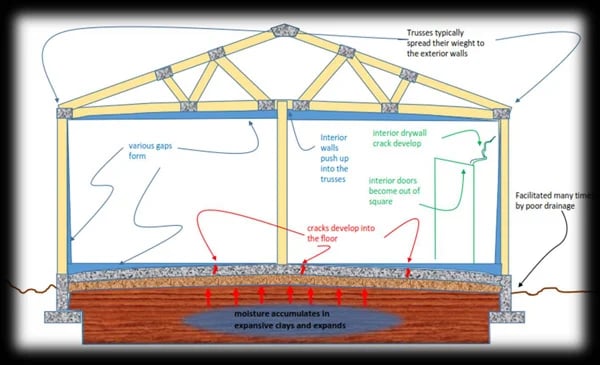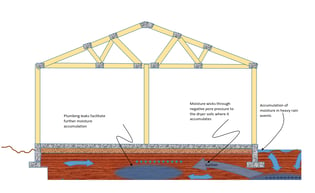Recently Dave Deatherage of Copper State Engineering brought to my attention a portion of a book written by Robert W Day called Foundation Engineering Handbook sanctioned by ASCE. I studied a similar book by this author in order to pass the exam required for the CFRS designation from the National Foundation Repair Association. The page Dave sent me is displayed below. He recognized that it is a confirmation of what I have been saying for many years.

I ordered the book to learn more. Essentially Mr. Day recognizes that moisture accumulation starts on the perimeter and over time works its way to the center of the foundation slab on grade where there are expansive soils present especially in more arid climates where the Thornthwaite index is lower. I have made this claim in several blogs.
In this blog I lay out the basic difference between heave and settlement. Click here.
In this blog I give the 4 mechanisms of how moisture accumulates under an existing slab on grade foundation. https://www.foundationaz.com/blog/why-moisture-accumulates-under-a-foundation-slab . In particular I also read on page 9.26.2 confirmation of the 2nd mechanism: Thermal movement of the subsurface of water vapor. I first learned of this from Claudia Zapata, Geotechnical professor at ASU. Mr. Day goes on to explain the first principles. Ie warmer more energetic vapors by diffusion spread to cooler less energetic areas.
https://www.foundationaz.com/blog/the-age-of-the-structure where I discuss the time required to accumulate moisture to the center of a slab on grade foundation.
https://www.foundationaz.com/heave-settlement where I show how expansive heave results in center heave or a dome heave pattern.
I also go into more detail on all of these issues in my upcoming book “Foundation Repair Secrets”, soon to be published by Advantage Books.
It also indirectly supports my claim that older homes with dome heave will be temporarily made worse with perimeter drainage improvement alone. If the soil on the perimeters is already drier and shrunken, drying it out more exacerbates the problem.
Drying out the areas with the most moisture induced heave makes a lot more sense. Hence the reason why we take careful measurements of the floor elevation in order to place the suction pit at or near the apex of the dome heave. This results in reducing the moisture the most in the areas that have the greatest problem.
I know that many engineers do not take my claims seriously because even though I have a bachelors from the ASU School of Architecture, and have had licensed engineers in my employ for over 10 years, I am not a licensed engineer. Once in a while it feels good to be vindicated by experienced forensic geotechnical engineers.






